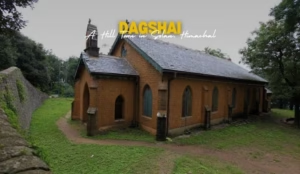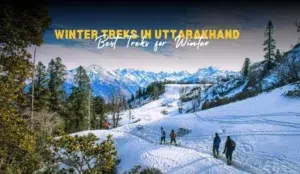“Discover the Himalayan wonders with Dhakuri Trek! 🚶♂️ Explore lush trails, culture, and glaciers in Uttarakhand. Start your adventure today! ⛺ “
About Dhakuri Trek
In the Kumaon Himalaya region of Uttarakhand, in the Bageshwar district, is where you can find Dhakuri. surrounded by an evergreen oak and horse chestnut forest. Dhakuri is a meadow at a high elevation that is remarkably flat. Any weary hikers will be glad to see Dhakuri.
- Overview:
- Dhakuri Trek is a popular hiking trail located in the Kumaon region of the Indian state of Uttarakhand.
- This trek offers breathtaking views of the Himalayan mountains, lush forests, and serene meadows.
- History:
- The history of Dhakuri Trek is closely intertwined with the region’s cultural and geographical significance.
- While there is no specific historical event associated with the trek, it has been used by local communities for centuries as a means of communication and trade within the remote Himalayan villages.
- Historically, these trails served as important trade routes connecting the Kumaon region with Tibet.
- The trek’s historical importance is reflected in the ancient temples and shrines that can be found along the route, showcasing the religious and cultural heritage of the region.
- Geographical Significance:
- Dhakuri is a picturesque meadow situated at an elevation of around 2680 meters (8792 feet) above sea level.
- It serves as a crucial resting point for trekkers on their way to various destinations in the Kumaon Himalayas, such as Kafni Glacier and Pindari Glacier.
- The location’s strategic significance, combined with its natural beauty, has contributed to the enduring popularity of Dhakuri Trek among adventure seekers.
- Flora and Fauna:
- The trail is surrounded by diverse flora and fauna, including oak and rhododendron forests, making it a paradise for nature enthusiasts.
- Trekkers have the opportunity to spot various Himalayan wildlife species, such as musk deer, snow leopards, and numerous bird species.
- Cultural Experience:
- Along the trek, trekkers can interact with the local communities, gaining insights into the traditional way of life in the Himalayan villages.
- The warm hospitality of the villagers and their unique customs add to the cultural richness of the Dhakuri Trek experience.
- Modern Popularity:
- In recent years, Dhakuri Trek has gained popularity among trekkers and adventure enthusiasts from around the world.
- Trekking agencies and tour operators now offer guided expeditions, making the trek more accessible to a wider range of adventurers.
- Challenges and Precautions:
- Dhakuri Trek, like many high-altitude treks, presents challenges such as changing weather conditions and altitude sickness.
- Trekkers are advised to be well-prepared with appropriate gear, including warm clothing and trekking boots.
- Acclimatization is crucial to minimize the risk of altitude-related health issues.
Why is Dhakuri Trek Famous:
- Scenic Beauty:
- Dhakuri Trek is renowned for its breathtaking scenic beauty, with panoramic views of the Himalayan mountain range.
- Trekkers are treated to vistas of snow-capped peaks, lush meadows, and dense forests, making it a visual delight.
- Access to Glaciers:
- One of the primary reasons for its fame is its strategic location, serving as a gateway to several prominent glaciers, including the Pindari Glacier and Kafni Glacier.
- These glaciers are natural wonders, attracting trekkers and nature enthusiasts from all over the world.
- Cultural Experience:
- The trek offers an opportunity to immerse oneself in the local culture of the Kumaon region.
- Trekkers can visit ancient temples and interact with the friendly locals, providing insights into the rich heritage of the area.
- Wildlife Spotting:
- Dhakuri Trek is known for its diverse flora and fauna, making it a hotspot for wildlife enthusiasts.
- The chance to spot rare Himalayan wildlife, such as musk deer and elusive snow leopards, adds to its allure.
- Adventurous Challenge:
- It offers a moderate level of challenge, making it suitable for both beginners and experienced trekkers.
- The thrill of trekking at higher altitudes and conquering steep ascents is a significant draw.
Things to Do in Dhakuri Trek:
- Trekking and Hiking:
- The main activity is trekking through the picturesque landscapes of the Kumaon Himalayas.
- Explore the well-marked trails, including the route to Pindari Glacier or Kafni Glacier.
- Photography:
- Capture the stunning views of snow-capped peaks, alpine meadows, and vibrant rhododendron forests.
- It’s a paradise for photography enthusiasts.
- Visit Ancient Temples:
- Take time to visit the historic temples and shrines along the trek.
- Learn about the local religious practices and architecture.
- Wildlife Watching:
- Keep an eye out for Himalayan wildlife, especially during early morning and late evening.
- Birdwatchers can spot various species in the region.
- Camping:
- Camp under the starry Himalayan skies at designated campsites.
- Enjoy a bonfire and connect with fellow trekkers.
- Interaction with Locals:
- Engage with the hospitable villagers, taste local cuisine, and learn about their traditional way of life.
- This cultural exchange is a unique aspect of the Dhakuri Trek.
- Explore Nearby Attractions:
- Besides the glaciers, explore nearby attractions like the village of Khati and its ancient wooden houses.
- Visit Zero Point for stunning views of the Pindari Valley.
- Nature Appreciation:
- Simply relish the serenity and tranquility of the Himalayan wilderness.
- Meditate, practice yoga, or enjoy a peaceful picnic amidst nature.
Things to Know about Dhakuri Trek:
- Trekking Season:
- The best time to embark on the Dhakuri Trek is typically from May to June and September to October.
- These months offer pleasant weather conditions with clear skies and moderate temperatures.
- Permits and Permissions:
- Trekkers need to obtain permits, usually from the forest department, before starting the trek.
- Ensure you have all the necessary documents and pay the required fees.
- Physical Fitness:
- Dhakuri Trek is considered a moderate trek, but it still demands a reasonable level of physical fitness.
- Engage in pre-trek fitness activities and consult a doctor if you have any health concerns.
- Altitude Considerations:
- Dhakuri is situated at a moderate altitude, but it’s important to acclimatize properly.
- Take it slow, stay hydrated, and be aware of the symptoms of altitude sickness.
- Packing Essentials:
- Pack appropriate clothing for varying weather conditions, including layers for warmth.
- Carry essential trekking gear, a sturdy backpack, and a first-aid kit.
- Guided vs. Independent Trekking:
- You can choose to trek independently or hire a local guide.
- Guides offer valuable insights, help with navigation, and enhance the overall experience.
- Safety Measures:
- Inform someone about your trekking plans and itinerary.
- Follow safety guidelines and stay updated on weather forecasts.
- Environmental Responsibility:
- Practice Leave No Trace principles by carrying out all your waste.
- Respect the local environment and wildlife.
How to Reach Dhakuri Trek:
- By Air:
- The nearest major airport is Pantnagar Airport (approximately 220 kilometers away).
- From Pantnagar, hire a taxi or take a bus to reach the trek’s starting point.
- By Rail:
- Kathgodam Railway Station, situated around 190 kilometers from Dhakuri, is the closest railhead.
- Regular trains connect Kathgodam with major cities like Delhi and Kolkata.
- By Road:
- The journey to Dhakuri often involves a road trip from Kathgodam or Haldwani.
- Numerous buses and shared taxis ply on this route.
- Private vehicles can be hired for a more flexible and comfortable journey.
- Trek Starting Point:
- The Dhakuri Trek usually starts from a place called Loharkhet, which can be reached by road from Kathgodam or Haldwani.
- From Loharkhet, the trekking trail takes you through scenic villages and forests to reach Dhakuri.
- Local Transportation:
- While on the trek, local jeeps or mules may be available for carrying heavy equipment or supplies.
- Consult your guide or local contacts for transportation options within the trekking area.
- Travel Tips:
- Be prepared for mountainous roads, which may be narrow and winding.
- It’s advisable to arrange transportation in advance, especially during peak trekking seasons.
Travel Tips for Dhakuri Trek:
- Plan and Prepare:
- Start planning your Dhakuri Trek well in advance, considering factors like permits, gear, and accommodations.
- Create a comprehensive checklist to ensure you have all the necessary items.
- Physical Fitness:
- Engage in regular physical activity and stamina-building exercises before the trek.
- Focus on cardiovascular fitness and leg strength to tackle the trail effectively.
- Acclimatization:
- Spend at least a day acclimatizing in the nearest village or base camp to adjust to the altitude.
- Hydrate well and avoid alcohol or strenuous activities during this period.
- Pack Light:
- Keep your backpack as light as possible by carrying only essential items.
- Opt for lightweight and moisture-wicking clothing to stay comfortable.
- Weather Awareness:
- Check the weather forecast for the trekking period.
- Pack accordingly, including warm layers, rain gear, and a good quality sleeping bag.
- Hydration and Nutrition:
- Stay hydrated throughout the trek by carrying a reusable water bottle and purifying tablets or filters.
- Consume energy-rich foods, and pack snacks like nuts and energy bars for quick boosts.
- Responsible Trekking:
- Follow Leave No Trace principles by disposing of waste responsibly and avoiding littering.
- Respect local customs and wildlife, refraining from disturbing or feeding animals.
- First-Aid Kit:
- Carry a well-equipped first-aid kit with essentials like bandages, antiseptics, and pain relievers.
- Know how to use the items in the kit or travel with someone who does.
- Safety in Numbers:
- Trek with a group or at least one partner, as trekking alone in remote areas can be risky.
- Communicate your plans to someone back home and provide regular updates.
- Local Knowledge:
- If trekking independently, acquire local maps and gain insights from the villagers about the trail.
- Hiring a local guide can enhance your safety and understanding of the region.
Best Time to Visit Dhakuri Trek:
- Spring (May to June):
- This period offers pleasant weather with clear skies and blooming rhododendrons.
- It’s an excellent time for nature enthusiasts and photographers.
- Autumn (September to October):
- Post-monsoon, the landscapes are lush and vibrant.
- The weather remains stable, making it ideal for trekking.
- Avoid Monsoon (July to August):
- Monsoon brings heavy rainfall, making the trails slippery and potentially dangerous.
- Landslides and leeches can be common during this season, so it’s best to avoid trekking.
- Winter (November to April):
- Winters are extremely cold, with heavy snowfall blocking the trails.
- This season is not recommended for trekking, as access to higher altitudes may be restricted.
- Special Considerations:
- For those interested in witnessing the glaciers, late spring and early autumn are the best times to visit.
- Trekking during the best weather seasons ensures a safer and more enjoyable experience.
Places to Eat Near Dhakuri Trek:
- Loharkhet:
- Loharkhet, the starting point of Dhakuri Trek, offers a few local eateries serving simple North Indian and Kumaoni cuisine.
- You can savor dishes like dal, rice, chapati, and vegetables prepared in local flavors.
- Khati Village:
- Khati, a charming village en route to Dhakuri, provides homestay options where you can enjoy authentic Kumaoni meals.
- Don’t miss out on the opportunity to taste local specialties like Bhatt Ki Churdkani, a traditional Kumaoni black soybean curry.
- Dhakuri Campsites:
- Many trekking agencies and guides arrange campsite meals as part of the trekking package.
- The camp cooks prepare nourishing meals, often including soups, pasta, rice, and local dishes to refuel trekkers.
Nearby Places to Dhakuri Trek:
- Khati Village (2 km from Dhakuri):
- Khati is the last inhabited village on the way to Dhakuri and offers a glimpse into the local culture.
- Explore its wooden houses and interact with friendly villagers.
- Pindari Glacier (16 km from Dhakuri):
- Pindari Glacier, accessible from Dhakuri Trek, is a major attraction.
- Enjoy a day excursion to witness the glacier’s stunning ice formations and surrounding landscapes.
- Kafni Glacier (10 km from Dhakuri):
- Another glacier worth exploring is the Kafni Glacier, accessible via a trek from Dhakuri.
- It boasts pristine surroundings and breathtaking views.
- Zero Point (6 km from Dhakuri):
- Zero Point offers panoramic views of the Pindari Valley and is a great spot for photography.
- Trek to this viewpoint for a memorable experience.
- Song (12 km from Dhakuri):
- Song is a small hamlet known for its natural beauty and serene ambiance.
- You can rest here on your way to or from Dhakuri and enjoy the tranquil surroundings.
- Loharkhet (Starting Point of Dhakuri Trek):
- Loharkhet is the gateway to Dhakuri Trek and is known for its picturesque setting.
- Explore the village, visit local markets, and interact with the residents.
Conclusion:
In conclusion, Dhakuri Trek stands as a captivating journey through the heart of the Kumaon Himalayas, attracting adventure enthusiasts, nature lovers, and those seeking cultural experiences. While the trek has no specific historical event tied to it, its history is embedded in the ancient trails and traditions of the region, making it a unique and enriching adventure.
With breathtaking landscapes, opportunities to spot Himalayan wildlife, and a chance to connect with the warm-hearted locals, Dhakuri Trek offers an unforgettable exploration of nature and culture in the lap of the Himalayas.
Frequently Asked Questions (FAQs) about Dhakuri Trek:
What is the level of difficulty for Dhakuri Trek?
-
- Dhakuri Trek is considered a moderate trek, suitable for both beginners and experienced trekkers. However, it’s important to be physically fit and prepared for varying weather conditions.
Is it necessary to hire a guide for Dhakuri Trek?
-
- While trekking independently is possible, hiring a local guide is recommended. Guides provide valuable insights, enhance safety, and contribute to the overall experience.
What permits are required for Dhakuri Trek, and how can I obtain them?
-
- Trekkers need permits, usually from the forest department, before starting the trek. These permits can be obtained in advance from the relevant authorities in the region.
What is the best time to visit Dhakuri Trek?
-
- The best times to visit are during spring (May to June) and autumn (September to October) when the weather is pleasant. It’s advisable to avoid monsoon (July to August) and winter (November to April) due to adverse conditions.
Are there accommodations and food options available along the Dhakuri Trek route?
-
- Accommodations range from local guesthouses to camping options. Food is available at villages like Loharkhet and Khati, and trekking agencies often provide meals at campsite locations. It’s advisable to carry some essential snacks and supplies for the journey.





